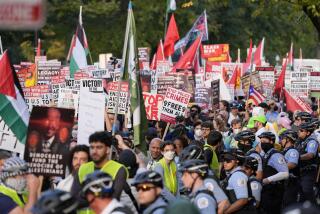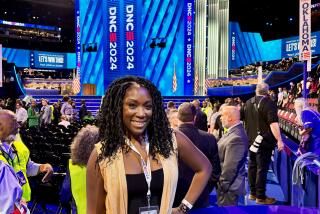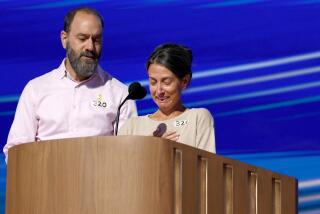Soviets Tripped by Access Curtain
- Share via
ATLANTA — Glasnost has found its way to this week’s Democratic National Convention.
But the first Soviet TV crew ever assigned to such an American event is not easily finding its way onto the jammed Omni arena floor. Or getting access to top Democrats.
“The leaders of the Democratic Party are very shy to give interviews to the Soviet Union,” said Boris A. Kalyagin, 50, a top Soviet TV commentator who is here with cameraman Arkadi Gromov.
His requests for interviews with Jesse Jackson, Massachusetts Sen. Edward M. Kennedy and Democratic National Committee Chairman Paul G. Kirk Jr. were rejected, said the Moscow-based Kalyagin. “Now we will try to get the mayor of Atlanta (Andrew Young), at least.”
Soviet radio and Tass, the Soviet news agency, have covered past Democratic and Republican conventions. This first-time Soviet TV presence, though, is “of course an influence of glasnost and perestroika (restructuring),” Kalyagin said.
About his inability to secure permanent convention floor passes for himself and Gromov, however, Kalyagin complained: “We feel like second-class citizens. I came especially from Moscow, the leading political observer, the first time a Soviet crew comes to a convention, and they said, ‘Sorry, we don’t have any passes to the floor. You will be put on rotation.’ ”
The Soviets don’t send Kalyagin out routinely. He is no small fry on Soviet TV, where he hosts two programs and has interviewed such world leaders as President Reagan and British Prime Minister Margaret Thatcher. “He’s a big guy there,” said Stuart Loory, former Moscow correspondent for CNN.
Nevertheless, if Kalyagin, Gromov and a third Soviet broadcaster, a radio man from Moscow, want access to the Omni, they must stand in line each night with about 200 other foreign media in hopes of gaining temporary passes, said Bill Headline, who is in charge of Omni passes for foreign broadcasters in his capacity as foreign-broadcast producer for the U.S. network pool. And those passes will get them only about 30 minutes in the hall or 15 minutes on the floor, Headline said.
Obviously, Atlanta is a long way from Red Square and Moscow’s recent Reagan-Gorbachev super-summit imagery. The powerful Soviet Union, required to line up here perhaps behind Haiti or Iceland or Honduras or Colombia? This is democracy in action.
“It is not fair,” said Kalyagin, whose reports from Atlanta are appearing on the main Soviet nightly news program, “Vremya,” and “International Panorama,” a Saturday magazine program that he hosts. “We want to film ourselves the faces of the delegates and feel the atmosphere of the convention. Now to get in, there will be a long queue.”
U.S. media also are experiencing a space crunch that limits their mobility in the undersized Omni. So Kalyagin is not alone in feeling abused.
“I said I’d try to help him out if I can,” Headline said. “But there aren’t enough passes to go around.”
Given the Kremlin’s history, Kalyagin is in a weak position to protest Omni press restrictions. Although press curbs have diminished under glasnost’s limited freedom of expression, Western media were still barred from the recent Communist Party special conference that debated Soviet leader Mikhail S. Gorbachev’s economic and political reforms. U.S. reporters had to rely on government briefings and other sources.
Still, in the spirit of America’s warmed relations with the superpower Soviets, shouldn’t they get just a small break here?
“They are just another broadcaster,” Headline said.
Maybe not.
Kalyagin’s reports are being transmitted to Moscow through the facilities of CNN, whose owner, Ted Turner, has a special kinship with the Soviet Union through programming arrangements and the co-staging of the Goodwill Games. And Turner’s company has leasing rights for the Omni, which is adjacent to CNN.
After complaining about his difficulty getting onto the convention floor, Kalyagin later reported that he had been guaranteed permanent floor access by Ted Turner’s son, Teddy, who is CNN’s special projects manager.
Not exactly. Said Teddy Turner: “All I did was promise I would try, but at this late date, it’s going to be hard.”
Meanwhile, Kalyagin’s pre-convention story ran on the Monday “Vremya” that was available for viewing at CNN here via satellite. It showed scenes of downtown Atlanta, vendors in the convention complex, Massachusetts Gov. Michael S. Dukakis and Texas Sen. Lloyd Bentsen arriving at the airport and Jesse Jackson surrounded by supporters.
However, the three-minute story was more noteworthy for what it omitted:
Footage of Sunday’s volatile confrontation between Atlanta police and demonstrators protesting a scheduled white supremacist rally that failed to materialize. Minor violence erupted, creating the kind of media-overblown, people-versus-cops clash that the Soviets could have edited to make America resemble an oppressive police state.
“In the old days, maybe I would show more about these demonstrations,” Kalyagin said. “Now, we can say more than before.”
It’s true that Soviet media have become more balanced in depicting the United States, Marshall I. Goldman, associate director of Harvard’s Russian Research Center, said by phone from Cambridge, Mass. “There’s more variegated coverage of the U.S. because Soviet people were beginning to say, ‘If it’s been so bad all these years, how come it’s so good?’ ”
Said Kalyagin: “If before we give main attention to the social struggle and unemployment, now we think we have to send more reports about those who work, because they are in the majority. We want to tell the truth about the United States--good things and bad.”
Into which category the Democratic convention falls is unknown.
More to Read
Sign up for Essential California
The most important California stories and recommendations in your inbox every morning.
You may occasionally receive promotional content from the Los Angeles Times.










